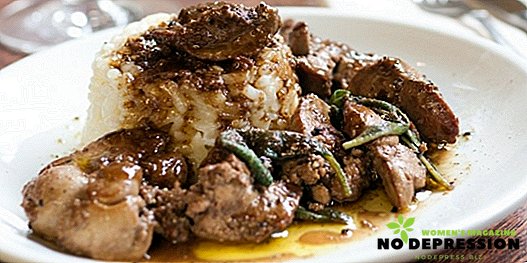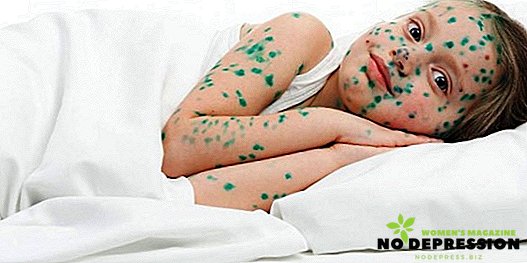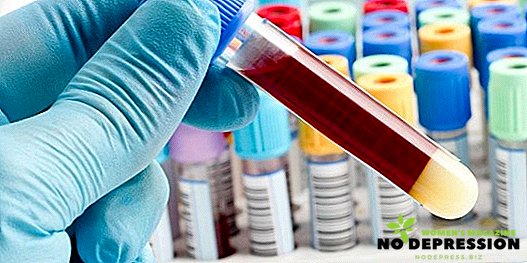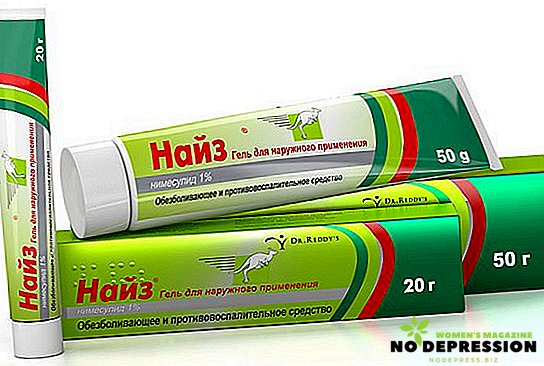Gastritis of varying severity today suffers almost everyone. Even children can "boast" of the presence of this disease. The older a person becomes, the brighter the inflammation of the gastric mucosa becomes. A quick rhythm of life, snacking at work, eating a dry meal, fast food - all this leads to neglected gastritis, an ulcer or oncology. In order not to bring your body to the last point, you should always carefully consider what and how often we eat, periodically pass FGDS or examination of the stomach.
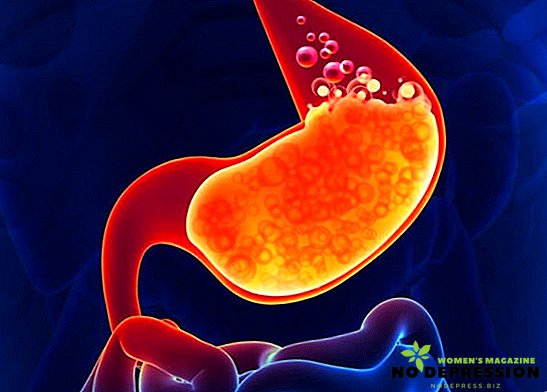
What is superficial gastritis?
Gastritis, like other diseases of the digestive tract, is acute and chronic. Chronic recurrent gastritis with a long course may ultimately cause pathological changes, degradation of the mucosa, atrophic gastritis, the symptoms of which are more pronounced in people over 50 years of age.
This is the most dangerous type of gastritis, which in the future may cause cancer. The initial stage, which is quite easy to diagnose - superficial gastritis. His treatment is carried out only in combination with proper nutrition.
All types of chronic gastritis in medicine are classified by:
- inflammation - fundal or antral;
- histology - superficial, atrophic, hyperplastic;
- by reason of occurrence - bacterial, endogenous, autoimmune.
Main types of superficial gastritis
Due to the variety of causes and locations, this disease can be divided into several types. Each type has its own symptoms.
In case of focal superficial gastritis, a focal lesion of the stomach lining may be observed. The disease may be accompanied by a feeling of heaviness in the abdomen, regardless of food intake, nausea. Separately, physicians emit a small focal form, with its superficial inflammation affects the mucous membrane, while being on small islands. The patient may complain of dyspepsia, loss of appetite.
 A dangerous form of pathology is diffuse gastritis. When it first becomes inflamed mucous membrane, then the process becomes chronic, resulting in atrophy of the glands of the stomach. At the same time, dead glandular epithelial cells are replaced with fibrous tissue, which, in turn, significantly increases the risk of cancer. The disease leads to avitaminosis, weakness, apathy.
A dangerous form of pathology is diffuse gastritis. When it first becomes inflamed mucous membrane, then the process becomes chronic, resulting in atrophy of the glands of the stomach. At the same time, dead glandular epithelial cells are replaced with fibrous tissue, which, in turn, significantly increases the risk of cancer. The disease leads to avitaminosis, weakness, apathy.
Ulcerative gastritis is observed when a mucous bacterium is infected with Helicobacter pylori. A neglected form of the disease can cause ulcers.
The patient feels heartburn, the urge to vomit, stomach pain, belching. Addiction to drugs or their long-term use can cause dysfunction of the gastric mucosa. As a result, it gradually becomes thinner and becomes covered by erosion. This leads to the fact that the digestive juice begins to erode the endothelium of the stomach until the appearance of bleeding.
Autoimmune gastritis is an atrophic inflammation in the thickness of the gastric mucosa. Antibodies to the cells of the stomach are formed in the body, which leads to the appearance of a large amount of hydrochloric acid. There is a burping of air, constipation can alternate with diarrhea, a person quickly gets tired, pigment spots form on the skin.
One of the most dangerous forms of gastritis is hyperacid. When it is against the background of a decrease in the secretory function of the glands, the mucous membrane inflames.
And because of the decrease in the production of hydrochloric acid in humans, the ability to absorb vitamins, useful substances that come from food, decreases. In the cavity of the stomach are formed gross growths, which can cause the formation of a tumor. Hyperacid gastritis is an inflammation of the stomach, which occurs on the background of high acidity. The patient has a sour eructation, a yellow patina can form on the tongue.
Catarrhal gastritis is the most common type of this disease. Inflammation occurs due to excessive consumption of spicy or fatty foods, neglect of diet. There is a strong belching, bloom on the tongue, sometimes vomiting with bile.
Hyperplastic gastritis is caused by lesions of the gastric mucosa. With this form of the disease, the epithelium grows heavily, until the appearance of solid polyps and folds. They may degenerate into a tumor. The patient is very much reduced appetite, until anorexia.
The fundal surface form is caused by autoimmune causes and can progress when exposed to antibodies on parietal gastric cells.
If the human body is prone to allergies, it may appear erythematous gastritis. In this case, eosinophils begin to accumulate in the mucosa, that is, protective cells, which can cause stomach pain and upset stool.
The main symptoms of superficial gastritis
Superficial or catarrhal gastritis is called so, because during the inflammatory process only the surface layer of the mucous membrane is damaged. And the younger a person is, the faster this layer will be restored, provided that the provoking factors cease. Some time after the irritating product or drink enters the stomach, it takes from 2 to 6 hours, the first symptoms may appear.
According to the intensity of the exacerbation of catarrhal gastritis is divided into weak, moderate and strongly pronounced. Accordingly, the symptoms of superficial gastritis are also expressed depending on the degree of pathological changes.
In chronic superficial gastritis, the glands are not affected during the inflammatory process and their change does not occur. Most often, this type of disease is observed in men. Sometimes the pain is quite pronounced, which resembles the attack of a peptic ulcer. But mostly patients complain of heaviness after eating, heartburn and belching.
 In acute superficial gastritis, the symptoms are as follows: at the very beginning appetite disappears, then weakness, dizziness appear, then nausea occurs, diarrhea, belching with a sour taste, unpleasant taste in the mouth, increased sweating or, conversely, dryness, a feeling of fullness or squeezing in the stomach.
In acute superficial gastritis, the symptoms are as follows: at the very beginning appetite disappears, then weakness, dizziness appear, then nausea occurs, diarrhea, belching with a sour taste, unpleasant taste in the mouth, increased sweating or, conversely, dryness, a feeling of fullness or squeezing in the stomach.
The intensity of the pain may be different: from acute cramping to tolerable in the right hypochondrium. Integuments more often turn pale. The tongue is covered with white or grayish bloom. A decrease in pressure and a rapid pulse of about 100 beats per minute are possible, and a blood test reveals neutrophilic leukocytosis.
Such symptoms of superficial gastritis can not occur without cause, it is usually preceded by the use of any product for a long time. Most often it is spicy or poor-quality food, a large consumption of coffee on an empty stomach, food dry, stress, long breaks in food and so on. If there are a lot of provoking factors and they act constantly, then even superficial gastritis can manifest itself painfully and unpleasantly. Usually the exacerbation lasts no more than 5 days, because during this period the mucous begins to recover.
But if this aggravation has arisen, then it should be examined to clarify the diagnosis, since these symptoms may appear in other diseases of the gastrointestinal tract. It is important to pay attention to what could be the cause of gastritis, to clarify the diagnosis and undergo treatment.
Treatment of superficial gastritis
Superficial gastritis gradually leads to dystrophic changes in the cells of the surface epithelium. To date, the main method for detecting gastritis is FGDs. Today, thanks to modern equipment, this procedure has become much easier for patients to carry. This diagnostic measure provides 100% information about the condition of the mucous membrane, with its help, the doctor determines what kind of gastritis the patient has.
Treatment for mild superficial gastritis is usually limited to avoiding bad habits and following a proper diet. Many patients in whom only superficial gastritis is found take this diagnosis lightly. However, medicine in the past few years has found a direct link between the development of gastritis and the bacterium Helicobacter pylori, which is in the stomach of every person.
When this bacterium is detected, it is imperative to undergo a course of treatment prescribed by a doctor. One diet food is not enough. If you abandon therapy, then not only the mucosal surface, but also deeper layers will collapse in the future.
 To combat the most common causative agent of gastritis - Helicobacter pylori, the doctor prescribes antibiotics and medications to reduce the acidity of gastric juice. The most commonly used drugs such as Metronidazole, Clarithromycin, Amoxicillin. The course of treatment should be determined by the doctor, but most often the therapy lasts about 2 weeks.
To combat the most common causative agent of gastritis - Helicobacter pylori, the doctor prescribes antibiotics and medications to reduce the acidity of gastric juice. The most commonly used drugs such as Metronidazole, Clarithromycin, Amoxicillin. The course of treatment should be determined by the doctor, but most often the therapy lasts about 2 weeks.
To reduce the acidity of gastric juice, omeprazole or ranitidine is usually prescribed. These drugs not only reduce the acidity of the stomach, but also help to protect the mucosa, relieve pain. It is also possible to use antacids to reduce acidity in the stomach. These drugs include Almagel and Maalox. In case of surface type of gastritis, the use of gastroprotectors is not carried out for treatment, since these drugs are necessary in the treatment of peptic ulcer.
Features of the diet
If this diagnosis is made, then therapy should begin with a change in lifestyle, giving up bad habits, and adjusting nutrition. It is worth remembering that in the absence of treatment and diet, even superficial gastritis can lead to oncology. Therefore, maintaining an optimally healthy lifestyle, reducing stress, correct opposition to it, the development of stress tolerance and proper nutrition are the key to long-term normal work of the gastrointestinal tract and the whole organism.
Dietary nutrition is one of the basics of the treatment of superficial gastritis. When the diet is important, the temperature regime of the dish - the temperature below +15 and above +60 degrees can cause the strongest irritation of the gastric mucosa, especially when consumed on an empty stomach. It will be optimal if the temperature of food at each reception will be close to + 35-37 degrees.
In addition, the consistency of the food is important. Products should be as crushed as possible, it is better to use them in a liquid or mushy state. It is recommended to avoid solid and coarse foods.
The daily ration should be about 3 kg, while in developing the diet and making the menu it is important to remember that a person should eat about 30% of the total daily calories for breakfast, about 15% for lunch and snack, about 40% for lunch and 15 % stays at the last dinner.
If patients have comorbidities such as pancreatitis, cholecystitis, then it is advisable to divide the daily ration into 6-8 servings. Dinner should be long before bedtime, at least 2-3 hours. Absolutely forbidden:
- transfer to;
- take long breaks in food;
- eat dry fish
Diet for superficial gastritis
The main thing for superficial gastritis is proper nutrition. It is forbidden to use:
- thick chicken broth, spicy, salted, pickled food;
- all foods that contain spices;
- preservatives, flavors, flavor enhancers;
- coarse, raw vegetables rich in fiber.

It is shown to include boiled chicken or rabbit meat, steam cutlets or meat dishes in the form of a souffle, fish of low-fat varieties, such as cod, pink salmon, pike, in the diet. Very useful grated vegetables or mashed. You can eat fruit in the form of juice or compote. As well as rice, semolina, oatmeal with milk and water or only water.
Folk remedies for this disease
Among the most famous and effective folk methods of treating surface gastritis can be distinguished vegetable juice. For example, potato juice is the most effective way to eliminate a small inflammatory process in the gastric mucosa. To make it, you need to squeeze the juice of ordinary potatoes through a juicer and drink it as early as possible, before it turns dark. First, they drink it a little, about 20 ml per 30 minutes before breakfast, lunch and dinner. Then the volume is increased to 100 ml at a time. The course of treatment is 3 weeks.
Cabbage juice is another good tool that can be consumed in the morning and evening before a meal of 100 ml, about an hour before meals.
In acute gastritis or in the case of exacerbation of chronic superficial gastritis, it is useful to take a decoction of flaxseed, as this seed forms mucus, similar in its properties to the mucus from oatmeal. If such a decoction is used, the gastric mucosa will be protected from acidic effects, which will contribute to its rapid healing after the inflammatory process.
To make such a decoction, you need: take one tablespoon of seed, boil it for 5 minutes, leave for 2 hours, then pass through a sieve. Use one tablespoon of this product before each meal. Also, do not do without herbs: take chamomile, celandine and St. John's wort in equal parts, pour two tablespoons of the collection of 400 ml of boiling water and leave overnight. The next day, 30 minutes before a meal, drink 50 ml of broth 1 to 4 times a day.


